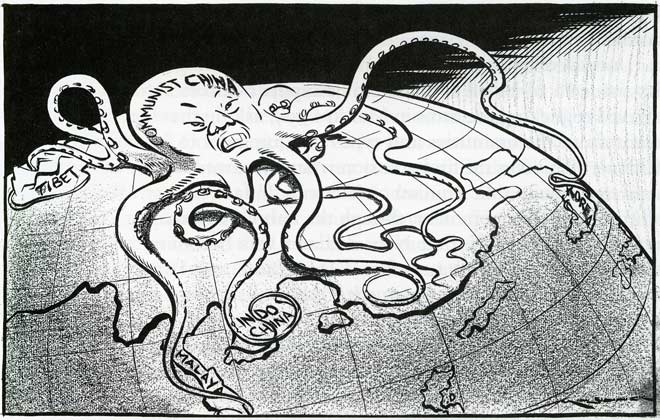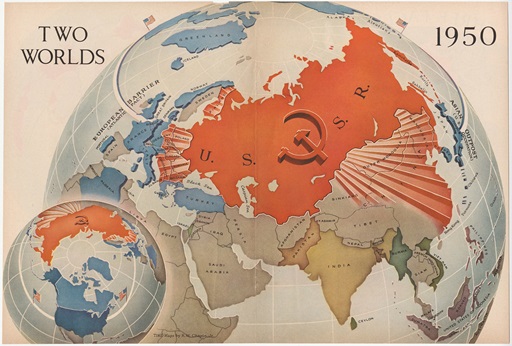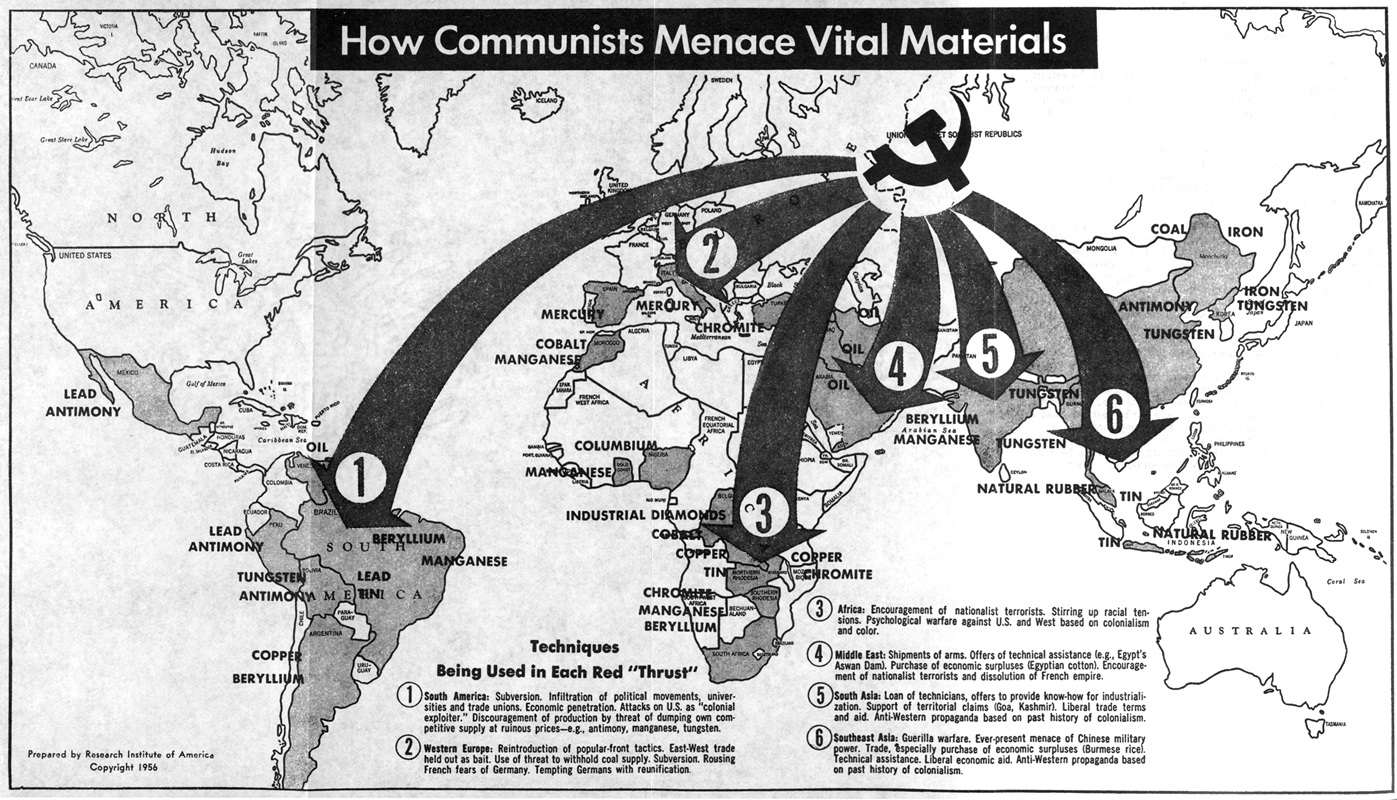|
|
NOTE: this topic is a key topic on the AQA specification. It is NOT a stated topic on the Edexcel, OCR or iGCSE specifications.
|
The spread of Communism in South-East Asia
During the Second World War, with their Western rulers gone, as local resistance groups fought alone against the Japanese occupation, two ideas took hold: • Nationalism: the idea that they had the right to rule themselves; • Communism: a desire for an economic system which applied the profits of work to the people, not the owners. Both these movements threatened the non-communist West.
|
Going DeeperThe following links will help you widen your knowledge:
This excellent YouTube video on the Domino Theory is essential watching
|
1. After the War - the Calcutta Conference of 1948If the Churchill's focus in 1946 had been on Europe, President Truman’s attention was drawn also to the Far East, where the collapse of the Japanese Empire in 1945 had created a power vacuum - similar to that in eastern Europe - where countries were beginning to be threatened by, and fall to, Communism: • In February 1948 a Southeast Asian Youth Conference was held in Calcutta, in India, attended by delegations from Burma, China, Ceylon, India, Indonesia, Malaya, Nepal, Pakistan, the Philippines, the Soviet Union and Vietnam. Although most of the delegates were non-communists, as Time magazine put it: “a planeload of experts from Moscow came to give their orders”, and Communist offensives were launched later that year by the Malayan Communist Party against the British, and also in Burma, Indonesia and the Philippines. • Even in strongly pro-western Thailand there were a series of communist demonstrations in 1952 known as the 'Peace rebellion'.
|
Source AThe department has watched closely the rapid increase of Communist activity which has taken place in Southeast Asia since early this year and has naturally taken the development into consideration in determining its course of action ... However, little attention has been directed toward one major stratagem employed by the Communists. To win support and allies in their drive for power, Communist leaders have consistently pretended to champion the cause of local nationalists and have attempted to identify communism with nationalism in the minds of the people of the area. US State Department Press Release (September 1948).
|
2. China, 1949In 1928, Chiang Kai-shek (leader of the Guomindang Chinese Nationalist movement) had passed the Organic Law, which gave him dictatorial power as Chairman of the Nationalist Government of China. He tried to exterminate the Chinese Communists, and in 1933-34 encircled them in Jiangxi, seeking to starve them into defeat. However, the Communists broke out and escaped to northern China (the ‘Long March’), and they grew in power and influence during the Second World War. Therefore, although the Americans reinstated Chiang Kai-shek as ruler of China in 1945, after a 4-year civil war, the GMD were defeated and in October 1949 Communist leader Mao Zedong proclaimed the People’s Republic of China, saying: ‘China has stood up’. Very quickly, in December 1949, Mao signed the Treaty of Friendship, Alliance and Mutual Assistance with the USSR; the Soviets sent experts, aid and loans. After his defeat in 1949, Chiang Kai-shek and his forces had retreated to the island of Formosa (Taiwan) and set up there a 'Republic of China' (ROC); in 1950 Mao Zedong massed a significant military force in the Chinese province of Fujian, and there was a constant threat that China would invade. Also, in October 1950, the People’s Liberation Army crossed into Tibet, which was duly absorbed into China. China turning Communist was a major concern for the US in the far east, and a significant setback for their policy of containment.
|
You can read about Events in China in more detail in the section on China on this website.
Source BOver this weekend we have learned the extent of the disaster that has befallen China and the United States. The responsibility for the failure of our foreign policy in the Far East rests squarely with the White House. So concerned were our diplomats with the imperfection of the democratic system in China, and the tales of corruption in high places, that they lost sight of our tremendous stake in a non-Communist China. This House must now take up the responsibility of preventing the onrushing tide of Cornmunism from engulfing all of Asia John F Kennedy (who later became President Kennedy) speaking to US Congress on the Communist success in China (January 1949).
|
3. Korea, 1950Communism also gained a hold in Korea. After the defeat of Japan in 1945, the country had been divided (similarly to Germany) into two zones, with the Russians establishing a communist Democratic People’s Republic in February 1946, under Kim Il Sung in Korea north of the 38th parallel (line of latitude). Meanwhile, the Americans and the United Nations supported the creation in 1948 of the Democratic Republic of Korea (‘ROK’) in the south, led by fervent anti-Communist Syngman Rhee. All was not well in South Korea, however: • There was a General Strike (September 1946) and the Daegu Uprising (October 1946) against the US Military government. • There was an uprising on Jeju Island (April 1948), against which Syngman Rhee led an ‘eradication’ campaign of massacres.
In June 1950, with Stalin’s blessing, the North Korean Army invaded South Korea, easily defeated the ROKs, and almost immediately captured most of South Korea. This was a major concern for the US government. In 1950–1953 America fought the Korean War to stop Communist North Korea conquering South Korea.
|
You can read about Events in Korea in more detail in the page on the Korean War on this website.
Source CTo sit by while Korea is overrun by unprovoked armed attack would start a disastrous chain of events leading most probably to world war. John Foster Dulles, consultant to the Secretary of State, speaking to the President immeidately after the ROK invasion of South Korea.
Source DCommunist control of Southeast Asia would render the US psoition in the Pacific offshire island chain precarious and would seriously endager fundamental US security interests in the Far East. US National Security Council Secreat Memo (June 1952).
|
4. Indo-China, 1954During the Second World War, the Japanese had driven the French out of their colony in Indo-China. The resistance to the Japanese there was led, not by the French, but by Vietnamese freedom fighters who called themselves the Vietminh. They were led by two Vietnamese communists – Ho Chi Minh and Vo Nguyen Giap – but helped by the Americans … so when, after the war, Ho Chi Minh took over the country and set up a free, democratic republic of Vietnam, at first the Americans supported him. The French, however, had other ideas, and tried to re-take their colony. The Vietminh waged a guerilla was against them. A ceasefire was agreed in March 1946, but reneged on by the French in November 1946. The Americans, fearing Ho Chi Minh’s communism, gave the French $3 billion 1950-54 to help them stop the Vietminh conquering Vietnam. From China, Mao Zedong supplied the Vietminh with guns and artillery. By 1954, the Vietminh controlled all the countryside; the French had lost 90,000 dead and only held the cities and some military outposts. In March 1954, the Vietminh captured the strategic outpost of Dien Bien Phu. The French realised the game was up and withdrew. On 21 July 1954, Peace Talks at Geneva agreed to split the country into a communist-controlled North Vietnam under Ho Chi Minh. South Vietnam was to be ruled as a democratic country by Ngo Dinh Diem (a Vietnamese nobleman). Diem immediately refused to agree the settlement, but the Americans – determined to stop Communism in Vietnam at the 17th parallel as they had in Korea at the 38th parallel – promised to prop up Diem’s government with money and weapons. Thus began the disastrous involvement of the US in Vietnam
|
|
5. The Domino TheoryAt first, British and US diplomats were sceptical that Stalin would be able to exert influence so far from Russia. The fall of China to Communism utterly changed that – the Chinese Communist Party was known to have overseas branches or cells in Siam, French Indo-China, Malaya, Indonesia, the Philippines, Burma, Hong Kong … and to be in contact with many others. On 7th April, President Eisenhower gave a press conference in which he commented that, if one of the states of the far east was allowed to fall, others would follow like falling dominoes, and it was this ‘domino theory’ which was to dominate US foreign policy in the far east until after 1973 – it was used, for example, not just as Truman's justification for the War in Korea (1950-53), but by President Ford to try to get Congress to intervene in Africa in 1975, and by the Reagan administration to justify intervention in South America (1980) and Central America (1984).
Did You Know?Not every American believed in the Domino Theory. International relations expert Jerry Silverman claimed (1975) that it was a 'self-fulfilling prophecy' based on the mistaken belief that international relations was only about America versus Communism. And Political Science professor Jerome Slater called it (1987) a 'bandwagon' which underestimated the effectiveness of policy options other than direct military intervention.
|
Source EFirst of all, you have the specific value of a locality in its production of materials that the world needs. Then you have the possibility that many human beings pass under a dictatorship that is inimical to the free world. Finally, you have broader considerations that might follow what you would call the “falling domino” principle. You have a row of dominoes set up, you knock over the first one, and what will happen to the last one is the certainty that it will go over quickly. So you could have the beginning of a disintegration that would have the most profound consequences President Eisenhower, announces the 'Domino Theory', speaking at Press Conference, 7 April 1954.
Source FEisenhower was willing to risk a nuclear war in March 1955 because he believed what Chiang, ROC officials, the US Embassy in Taiwan, and the Asia experts at State and Defense were telling him: the loss of the offshore islands would lead to the loss of Taiwan and a loss of faith in the United States throughout Asia. George Kulacki, Nuclear Weapons in the Taiwan Strait (2020)
|
Source GA cartoon in the New Zealand Herald (November 1950).
Source H'Two Worlds', a Time map (1950).
|
Consider:1. Who does John F Kennedy blame in Source A for the fall of Chiang Kai-shek? 2. Do the Sources support the suggestion that the ‘domino theory’ dominated US foreign policy? 3. Using all the Sources on this page, make a list of all the aims of US foreign policy in the far east in the years 1945-1954. 4. How might the domino theory have become a 'self-fulfilling prohecy'?
|
Source IA map created by the Research Institute of America (an early private think tank) in 1956.
|
|
|
|
|
|
Spotted an error on this page? Broken link? Anything missing? Let me know. |
|
 Most
of the lands of south-east Asia - valuable for their products of sugar, rubber,
tobacco, coconut, tin and oil - were ruled in the 1930s by the Western nations as part of their colonial empires
(eg the French in Indo-China, the British in Hong Kong).
Most
of the lands of south-east Asia - valuable for their products of sugar, rubber,
tobacco, coconut, tin and oil - were ruled in the 1930s by the Western nations as part of their colonial empires
(eg the French in Indo-China, the British in Hong Kong).


